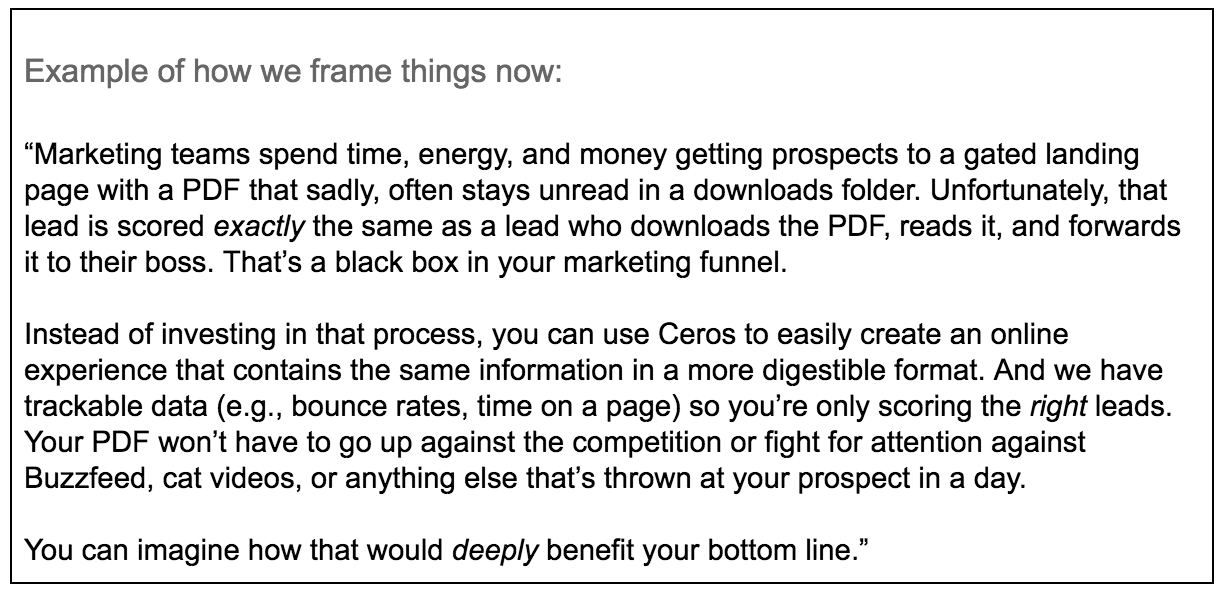Pitching Your Product as a Must-Have: Developing a Motion Sales that Works
Below are 5 things that can make or break a motion sales.
When prospects call us a ‘nice-to-have’ solution, it feels like a gut punch. Once they think of you that way, it means you haven’t created enough value in your motion sales conversations.
We had a problem with diversity at Ceros, which was that we sell an interactive digital canvas without developers. Our designers create animated content.
We knew we had to change the way that we talked about our product if it was going to become a “must-have” rather than just an extra.
We succeeded despite our obstacles. Here are the steps we took to make your motion sales work.
Request a Data License and Access the World's People + Company Data
Want 300 million+ profiles at your fingertips? Updated monthly with the data on your own server/host!
Including personal emails, business emails, mobile numbers, mailing addresses and more.
You get net worth, ages, company data, and more.
Use it for cold outreach, paid ad campaigns, direct mail, social selling or even cold calling.
Use it with unlimited access for your own app, outreach campaigns, or as a client service.
Oh, and did I mention we can identify individuals visiting your, or your client's, website?
Contact us for how you can access the entire dataset, on your own server. No more API limits, no price per contact.
Step 1: Change The Narrative
First, we created a new narrative for our motion sales deck. We stopped using the long-standing one that focused on product features and their benefits. Instead, it now focuses on changes happening in the customer’s industry.
We didn’t focus on what we offer, but rather the problems and opportunities that our company solves.
We modeled our new motion sales story after what Andy Raskin said about Zuora. It was a good fit because it’s visual and we sell to customers who know this is an important problem.
We go back to why we started
We realized that we are not just a company, but have an important story to tell. This made us stop thinking about our product and start telling the story of how marketers think differently now.
The big picture idea merged into more tangible and actionable stories that any marketer can relate to. As soon as prospects agreed with the information we were showing, they would find gaps in the market or new technology being adopted by other industries.
I found it much easier to get them on board with my idea.
Our story tells exactly why they should care
We also made our motion sales decks more interactive and dynamic. We incorporated feature-based anecdotes that would appeal to the client, depending on their needs.
It’s an easy story for prospects to understand. There will be winners and losers in the workplace, but there is also change happening.
Once we figured out what our audience would want to read, it was easier to get the nuances right.
Step 2: Redo Your Discovery Approach
We were asking all the wrong questions
The next shift was moving from discovery based on content to strategic, more long-term discoveries.
In the past, our motion sales discovery calls had mainly been about how well a company was doing with content marketing.
We asked the prospect a lot of questions about their marketing strategy.
- What kinds of things do you write about?
- How often do you create it?
- Creating more visual content can be a great way to help your business grow.
When we were asked questions like these, it automatically made us seem less valuable to our company and more of a low-level tool for the marketing department.
They didn’t stand out in a market of more than 5,000 marketers. Our questions made them sound like any other marketing tool.
Questions about real goals in business matter more
We talked about what VPs are looking for in a Marketing Director.
Most small businesses don’t focus on experiential marketing like the big brands do. They’re usually focused on generating revenue and looking for ways to plug holes in their sales funnel.
When we asked generic questions about content, our prospects were unclear on how it would help their bottom line. So instead of asking those types of questions, we began to ask probing ones that related more closely with the business targets.
- What are your goals for marketing in the next 6-12 months?
- So far, what have you tried?
- What gaps have you noticed in the company?
Now that we’ve shown them a clear connection between changing the content experience and revenue, they understand.
It’s forcing us to change our hiring process.

Step 3: Add the Changes in Your Sales Training
We didn’t just change our approach overnight. We tried some things and once we saw they were working, we had to figure out how to introduce the changes without causing too much disruption.
How can we get all employees to tell the same story?
We knew what our reps should be doing, but when they were face to face with customers we weren’t sure if they actually did it.
Let your representatives make their own version of your story
We needed training on the new messaging, then we could see who was doing well and who would need help.
The first thing the executives did was introduce a new deck and message to Account Executives, Customer Success Managers, and Sales Development Representatives. Instead of talking about our product, they focused heavily on how it solves problems for people.
We realized that by having everyone tell their story, it helped the new messaging become more cohesive.
Step 4: Assess And Monitor Continually
Once the new messaging was launched, we wanted to know how it would land. That’s when Gong.io came into play.
We recorded all of the sales meetings in Gong.io and quickly reviewed them to see if our messaging was a hit or miss.
We wanted to make sure we did not disrupt the company by making new changes, so we had someone track how it was working and adjust where necessary.
Step 5: Coach For Consistency
In the final step, we used Gong.io to see which reps were telling a good story and which ones weren’t.
I can’t coach my reps for success just with anecdotal evidence.
Gong.io has helped us roll out our new sales story and discovery process, which helps to keep track of how it’s doing.
Conclusion
If you’re facing the same objection over and over again, know that there are a few ways to turn it around.
Get insight into the conversations your customers are having. The most important thing is to tell a story from their perspective.
Request a Data License and Access the World's People + Company Data
Want 300 million+ profiles at your fingertips? Updated monthly with the data on your own server/host!
Including personal emails, business emails, mobile numbers, mailing addresses and more.
You get net worth, ages, company data, and more.
Use it for cold outreach, paid ad campaigns, direct mail, social selling or even cold calling.
Use it with unlimited access for your own app, outreach campaigns, or as a client service.
Oh, and did I mention we can identify individuals visiting your, or your client's, website?
Contact us for how you can access the entire dataset, on your own server. No more API limits, no price per contact.
Want to help contribute to future articles? Have data-backed and tactical advice to share? I’d love to hear from you!
We have over 60,000 monthly readers that would love to see it! Contact us and let's discuss your ideas!
